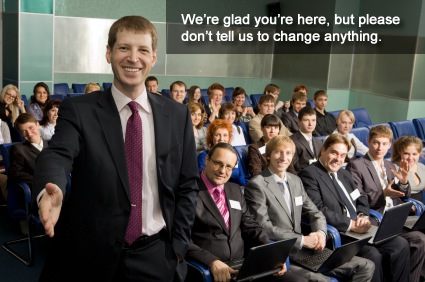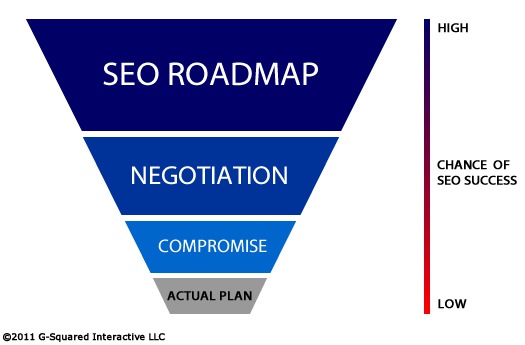Achieving success in SEO is hard. For many businesses, SEO is often a long process that first involves assessing and identifying weaknesses for a given site, working to remedy those problems as quickly as possible, and then forming a longer-term strategy for increasing rankings, targeted traffic, and ultimately conversions from organic search. This is a challenge for any size organization, but it’s exponentially more complex for large businesses.
Larger companies might contain several divisions and many key internal players that will be involved with the initiative. During my career, I’ve had a unique opportunity to experience this dynamic from several viewpoints. Specifically, I’ve led SEO in-house at several organizations, I’ve been part of a global interactive agency helping large brands with SEO, and I’ve also helped many companies as a consultant. This means I’ve had to deal with the internal battles and compromises that an in-house SEO faces, while also being on “the outside” as an agency and consultant. Based on this experience, I can usually tell within a short period of time whether a specific SEO initiative will be successful or if it won’t move the needle. Unfortunately, the failures in SEO that I’ve witnessed are typically based on various negotiations that take place internally and the resulting compromises that are agreed upon.
The Barriers, The Players, and The Compromises
When I begin helping new clients with SEO, I typically conduct a thorough SEO Audit, which produces a remediation plan and SEO roadmap. The roadmap is the list of all projects that need to be completed in priority order. There are times that the final audit presentation is 30-40 slides in length, and then there are more extreme cases where it’s over 70 or 80 slides. After the audit is presented to my client’s core team, a second meeting is usually held to create a plan of attack for fixing any serious structural problems and then tackling the rest of the projects that make up the SEO roadmap.
-This meeting is typically where it gets interesting.-
For larger businesses, you might have 10-15 people attend the meeting to represent their given department or function. To me, this meeting is critically important, as I’ve seen several SEO initiatives fall apart at this stage (at least from my perspective). There are times I leave this meeting energized knowing that we are going to move at light speed and have a great chance of success. But there are also times I leave the meeting knowing it’s going to be a long, tough road for my client, SEO-wise.

What Compromise Looks Like
As the various players go back and forth during the meeting, with what sometimes looks like a twisted game of SEO poker, negotiations start and compromises are made. There are times those compromises are minor, but there are also times those compromises are big enough to completely derail an SEO effort. The problem is that there might be key people involved that are unfamiliar with SEO, and they don’t know the extreme impact that those compromises could have. It might seem like a nice gesture in Corporate America to acquiesce, but from my perspective, certain compromises set the SEO team up for failure. And I despise failure.
For example, maybe the group agrees to tackle content optimization in Q1, but the massive canonicalization problem can’t be addressed until Q3 or Q4. Or how about you can fix the navigation and internal linking structure in Q1, but you’re told that you can’t fix the thousands of URL’s that randomly change until Q2 or Q3. Don’t laugh, I had to deal with this specific issue on a large scale (impacting millions of pages in total, and tens of thousands of URL’s that could change at any given time). Or how about agreeing to a robust content generation strategy, but each piece of content must pass through two internal committees (which will essentially water down the effectiveness of the content.) Needless to say, many of the compromises that take place won’t work well SEO-wise. You might simply end up spinning your wheels.
Below, I’ve included a graphic showing how you can start with a robust SEO roadmap (based on an audit) and how negotiations and compromise water down the effectiveness of the entire initiative.
The Compromise Funnel Shows Your Chance of Success in SEO
A Critical Decision for SEO’s – Do You Want To Build Friends or Do You Want To Build Success?
There’s a critical decision that needs to be made by SEO’s leading large-scale initiatives. The inherent problem with SEO is that you will inevitably ruffle some feathers in an organization (and that’s putting it nicely). This includes potential issues with your technology team, designers, copywriters, brand managers, PR directors, salespeople, etc. And many of the people involved are critical to the success of the effort (they comprise the critical last mile for SEO.)
The reason SEO often leads to conflict is simple. If a site is in bad shape SEO-wise, then your audit could end up revealing many problems. When the audit is presented, a company can either understand that change has to happen and take action, or they can start pointing fingers. That’s especially true if the company is spending a lot of money on paid efforts since SEO is not strong.
So, as you shine a light on various problems you encounter SEO-wise, you might have a critical decision to make. Should you aim to be nice to everyone, make compromises, and possibly fail, or will you drive forward, push for change, rub some people the wrong way, but have a greater chance of success? I’ve always chosen the latter, but that’s me. There are many people that choose the former, and remain frustrated as their rankings and traffic in organic search suffer. But, they have lots of friends internally, since they were nice to everyone. Let’s face it, change is uncomfortable for most people. And digital marketing will continually change the way businesses work and the way leaders must think.
For example, there’s an incredibly memorable debate I had with a Director of Branding about some changes to the homepage of a large site (for a large brand). It went something like this:
Director: Over my dead body will you be putting that new content and links on my homepage.
Me: Yes I am, and it’s going live in the next release (about 2 weeks from now).
Director: No, it’s not. It doesn’t match our branding. It won’t go live. {now standing up}
Me: Your search engine rankings are non-existent and we have 35 pages of changes to the site, based on the audit I conducted. This is the first of many changes and it’s going live in the next release.
Director: What, do you think everyone is searching Google right now for everything they need??
Me: (Now holding up keyword research) For the categories we are targeting, they sure are. Here’s the data. This is part of the reason we’re making the changes on the homepage.
This went on for about an hour. I won this specific battle, primarily since this was a massive SEO initiative that was going to have a profound effect on the business at hand. I also had clearance from the highest levels of the organization to make any changes I needed to in order to fix the current SEO situation. From my perspective, this was war (against poor rankings and bad SEO, not necessarily people). That said, I knew some people’s feelings could be collateral damage, which was an unfortunate reality.
Precogs for SEO – Boots on the Ground
There’s one thing I learned very early on in digital marketing. You’re only as good as the implementation. That means a solid strategy means nothing unless it’s executed properly. When you need to make massive changes to a large-scale website, you need close-to-flawless execution. You also need to be very close to the execution of those changes, as many of the changes will be completed by people that aren’t familiar with SEO. For example, a large-scale migration and redesign could have a lot of moving parts. There are dozens of opportunities for changes to be implemented incorrectly. It’s not because the people involved want to implement the changes incorrectly. They just aren’t familiar with SEO.
Based on how important execution is, I find it’s advantageous to understand as much as possible how a specific company’s development and release schedule works. For example, who will be implementing the changes, how fast are those changes typically completed, and how often are there glitches during the process. This can help you predict the future (or at least understand what you’re in for as changes are completed). In order to do this, you’ll need access to a precog, like in Minority Report. Don’t laugh, you might already have one in your own organization.
Precogs for SEO Will Often Reveal The Truth About Future Implementation

One way to truly get a feel for how an organization works (development-wise) is to speak with the right person. And that’s not necessarily the CMO, the CTO, or the Director of Technology. Instead, it’s often the Project Manager (PM). That’s right, PM’s know how projects get executed, how fast changes can be implemented, and how much pain you will need to go through to get things done. They are your SEO precogs. If you want the pulse of the website and technical organization, ask the PM’s. You might find that you refine your implementation plan based on your conversations with them. Remember, you want the truth at this stage, and in my experience, PM’s will give you the truth (partly since it directly impacts their day to day work).
A Note About Agencies and Consultants
If you are assisting a company as part of an agency or as a consultant, then you have another level of complexity to deal with. As an outsider, there’s a good chance you won’t have direct access to the people involved on a regular basis. And don’t underestimate the power of being able to directly walk into someone’s office. In addition, you probably won’t have access to the website, in order make direct changes. So, your success depends on internal resources at the company at hand. This simply means that although you might be in the driver’s seat strategy-wise, you’re in the back seat (or trunk) implementation-wise. This is just another reason to speak with the precogs before you begin tackling large-scale SEO efforts.
My Recommendations for Dealing With Large-Scale SEO Initiatives
Based on my experience, here are some recommendations that can help you avoid failure when driving change in SEO:
- Understand how the company works before starting. Speak with as many people involved before developing the SEO roadmap. And as I explained above, definitely speak with the Project Manager(s) that will be helping you.
- Educate the team as much as possible so compromise doesn’t kill your efforts. The more that people understand how each change can impact SEO (and in what order), the easier it will be for you. By doing this, you can cut down on compromises that just don’t make sense SEO-wise.
- Show the financial impact of making changes. I firmly believe that you should always bring data to a meeting. If not, you can debate opinion until the cows come home and nothing will ever get accomplished. Showing the potential financial impact of your SEO efforts can win people over.
- If you’re part of an agency or if you’re a consultant, you’ll need an SEO champion that’s in-house. Without someone driving the initiative internally, you’ll have a hard time succeeding.
- Make your decision, build more friends or build SEO success. You must make a hard decision and choose your path. Understand that your work will impact several departments and many people within those departments. Some won’t be happy with you. Feelings will be hurt. It’s a necessary reality.
- Form a solid communication plan. You should clearly communicate any changes taking place SEO-wise, as well as report on the results promptly. Be transparent and let the data speak for itself. Win over the naysayers.
Summary – Don’t Back Down
The more SEO projects you work on, the more you will run into the various situations I mentioned above. Large-scale SEO is rarely a simple process. Instead, it’s a multifaceted, long-term process that impacts several departments and many people within those departments. Negotiation and compromise will occur, but you need to make sure they don’t derail your initiative. You should understand that you can make a serious impact at your organization (or for your client), but you will probably have to make some tough decisions before you succeed. Don’t back down. Stand up for SEO. It can pay off for your company, your clients, and yourself.





